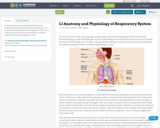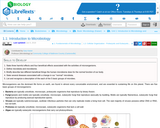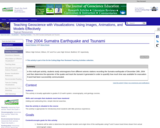
10th grade biology aligned to the standards that is free.
- Subject:
- Life Science
- Material Type:
- Full Course
- Date Added:
- 05/13/2015

10th grade biology aligned to the standards that is free.

In this resource we have explained the process of respiratory system including all the functions that are performed during the process of respiration. The role of each and every part involved in respiratory system is explained with proper diagrams as well.

In this resource we have explained the process of respiratory system including all the functions that are performed during the process of respiration. The role of each and every part involved in respiratory system is explained with proper diagrams as well.

In this resource we have explained the process of respiratory system including all the functions that are performed during the process of respiration. The role of each and every part involved in respiratory system is explained with proper diagrams as well.

Microorganisms are the dominant life forms on earth, are found in almost every conceivable environment, and are essential to sustaining life on this planet.

Outlines the 11-week schedule for students to successfully gain an introductory understanding of medical terminology/ Includes chapter links, learning objectives, and units of study.


1.2

An exercise on the effects of flooding that took place in the upper Mississippi River drainage basin in 1993, using before and after satellite images.
(Note: this resource was added to OER Commons as part of a batch upload of over 2,200 records. If you notice an issue with the quality of the metadata, please let us know by using the 'report' button and we will flag it for consideration.)

Analyze the effect of a 1996 controlled flood on a sandbar in Grand Canyon. This exercise uses Spatial Analyst and 3D Analyst.
(Note: this resource was added to OER Commons as part of a batch upload of over 2,200 records. If you notice an issue with the quality of the metadata, please let us know by using the 'report' button and we will flag it for consideration.)

Learn how important the honey bee's body structure is to survival in the hive. This lesson includes learning objectives, material and resource lists, background information, activities, reading selections, writing assignments, a game, assessments, and support documents. See the Educator's Guide for more video links and recommended readings.

Learn how important the honey bee's body structure is to survival in the hive. This lesson includes learning objectives, material and resource lists, background information, activities, reading selections, writing assignments, a game, assessments, and support documents. See the Educator's Guide for more video links and recommended readings.

This is a problem-based learning (PBL) group jigsaw activity. The scenario is:
Students are employees of a unit of the United Nations responsible for coordinating disaster relief after a major disaster (the 2004 Asian Earthquake and Tsunami) occurs. The agency needs to understand the situation in each country so that it can coordinate the work of various governments and nongovernmental organizations (NGOs) working in the affected area.
Students are divided into Expert Groups (related to academic specialties such as Economics, Medicine, Political Science, Earth Science, etc.) and spend several days researching their topics. Students are then reassigned to one of seven or eight Country Groups, based on the countries most affected by the disaster. Each country group needs someone representing each expert group. In the scenario, these groups correspond to task forces that must determine what the situation is in each country and try to assess the current need for international assistance.
Students research their country, using internet resources, especially the CIA World Factbook and ReliefWeb, the information coordination website of the United Nations. At a large-group roundtable discussion, each group presents what it has found about its assigned country. As a final product, each student writes an individual report summarizing findings and making recommendations for disaster assistance.
(Note: this resource was added to OER Commons as part of a batch upload of over 2,200 records. If you notice an issue with the quality of the metadata, please let us know by using the 'report' button and we will flag it for consideration.)

Students are employees of a unit of the United Nations responsible for coordinating disaster relief after a major disaster (the 2004 Asian Earthquake and Tsunami) occurs. The agency needs to understand the situation in each country so that it can coordinate the work of various governments and NGO (nongovernmental organizations) working in the affected area.
(Note: this resource was added to OER Commons as part of a batch upload of over 2,200 records. If you notice an issue with the quality of the metadata, please let us know by using the 'report' button and we will flag it for consideration.)

In this multi-part activity, students study seismograms from 3 different seismic stations recording the magnitude 9.0 Sumatra earthquake of December 26th, 2004. By comparing the arrival times of the P and S waves on each seismogram, students determine the distance from the epicenter to each station. Using that data, they can accurately map the location of the epicenter and the precise time of the earthquake. After locating the epicenter, students calculate the position of the tsunami generated by the quake at one hour intervals. From those determinations, predictions are made about how much time people had before the tsunami crashed onto their shores. Finally, students investigate some of the ways people can lessen the impact of the next great tsunami.
(Note: this resource was added to OER Commons as part of a batch upload of over 2,200 records. If you notice an issue with the quality of the metadata, please let us know by using the 'report' button and we will flag it for consideration.)

This activity uses data collected from DART (Deep-ocean Assessment and Reporting of Tsunamis) stations in the Pacific following the 2011 tsunami generated off the coast of Japan. Students are required to map the wave front after 5, 10, and 15 hours to better understand the speed and propagation of the tsunami wave.
(Note: this resource was added to OER Commons as part of a batch upload of over 2,200 records. If you notice an issue with the quality of the metadata, please let us know by using the 'report' button and we will flag it for consideration.)

This exercise uses the example of the March 28, 2014 M5.1 La Habra earthquake to teach about earthquake risk and resilience in southern California. Students will examine seismic waveforms recording during the earthquake, as well as read reports from scientific agencies and news outlets to answer basic questions regarding earthquake risk and resilience.
(Note: this resource was added to OER Commons as part of a batch upload of over 2,200 records. If you notice an issue with the quality of the metadata, please let us know by using the 'report' button and we will flag it for consideration.)

This resource is a video abstract of a research paper created by Research Square on behalf of its authors. It provides a synopsis that's easy to understand, and can be used to introduce the topics it covers to students, researchers, and the general public. The video's transcript is also provided in full, with a portion provided below for preview:
"It might sound like bad advice, but for Japanese men, eating a high-carb diet could actually be a good thing—only, it depends on the type of carb. Because eating too much of the wrong ones could have dire consequences. These are the findings reported by Professor Chisato Nagata and colleagues from the Gifu University Graduate School of Medicine in Japan—recipients of the inaugural British Journal of Nutrition Paper of the Year award. Their paper, published in volume 122, issue 7 of BJN, describes a subset of results from the Takayama Study. The study was launched in 1992 to link dietary and lifestyle factors to morbidity from cancer and other diseases. Participants filled out a questionnaire at baseline on how frequently they ate various foods..."
The rest of the transcript, along with a link to the research itself, is available on the resource itself.

This lesson will allow students to select and share what details are important on a topic. Groups of students will research a topic and then discuss and determine the top 25 important things someone should know about the topic.

This activity is designed for a primary classroom (outdoors & indoors) investigation where students collect and investigate soil samples and describe the soils, looking for similarities and differences. Students develop a method of recording the data colleted and can present the information gathered.